Menu
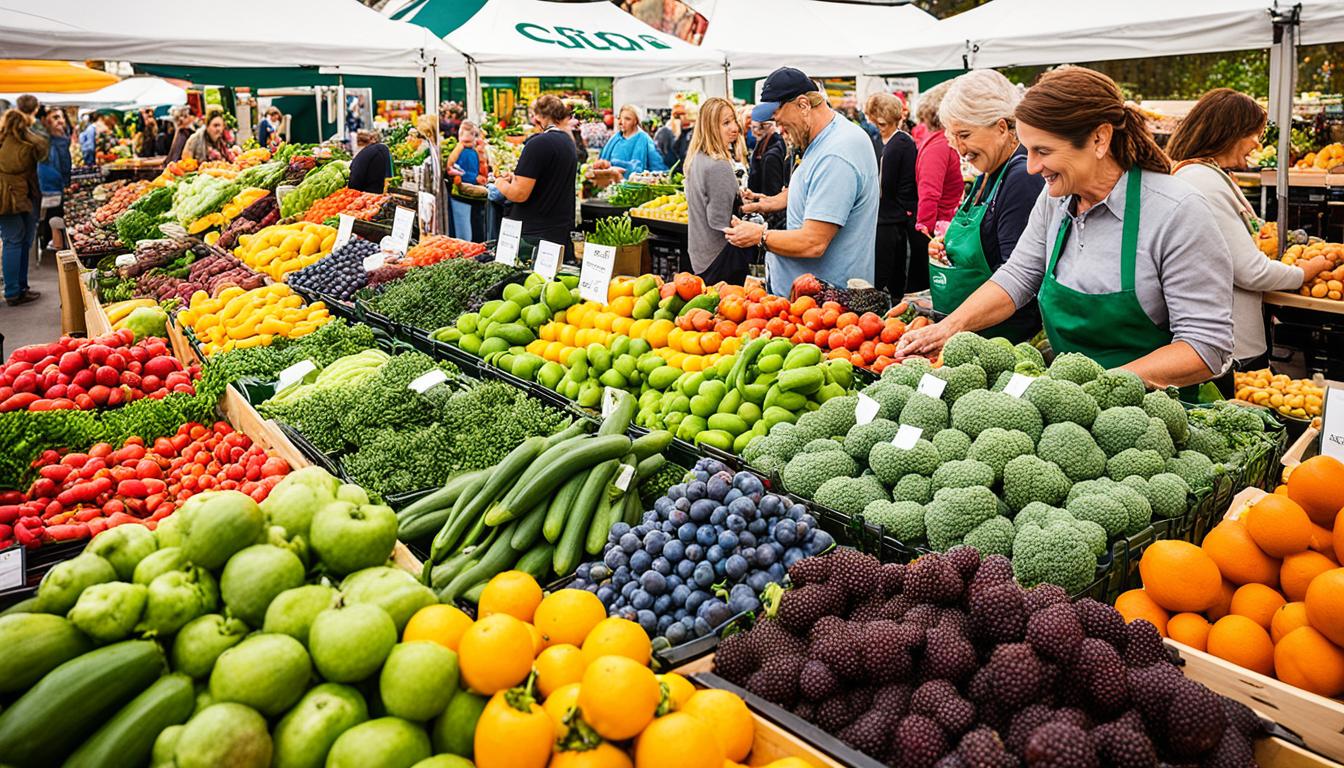
Did you know that U.S. sales of certified organic products soared to nearly $70 billion in 2023? The Organic Trade Association reported this. It’s a 3.4% increase from the previous year, showing a lively organic food scene. Organic food sales hit $63.8 billion, and other organic items added $5.9 billion. This increase, despite rising prices, points to people’s commitment to health and eco-friendly lifestyles. It promises growth in the organic market.
In the US, the organic market is growing fast. By 2023, it’s expected to hit $70 billion in sales. This info comes from the 2024 Organic Industry Survey by OTA. Even with tough times, people are showing their love for organic stuff.
Over the last ten years, the U.S. saw a big jump in organic farming. Certified organic cropland acres went up by 79%. Now, they cover 3.6 million acres. But pastureland and rangeland dropped by 22%, to just 1.3 million acres.
There are now over 17,000 organic farms, up by more than 90% in the 2011-2021 period. This growth shows a strong push for sustainable farming.
Sales in stores have been going up by 8% every year, jumping from $26.9 billion in 2010 to $52.0 billion in 2021. Fresh fruits and veggies are the most popular, making up 40% of all organic food sales.
Even with this good news, the organic market has its problems. The costs of making organic food can be high. This means the prices are often higher, which might put off some buyers. Still, the price gap with non-organic food is getting smaller, which is good news.
Most organic food, 56%, is sold in traditional grocery stores and supercenters. Another 32% comes from natural food supermarkets. Online, 6% of organic food sales happen. There’s a chance for more places to sell organic food in the future.
About 18% of organic farms talk directly to consumers. This personal touch can make a big difference. It helps farms build strong relationships with the people who buy their products.
| Aspect | Growth Rate | Period |
|---|---|---|
| Certified organic cropland acres | 79% | 2011-2021 |
| Pastureland/rangeland acres | -22% | 2011-2021 |
| Certified organic operations | 90% | 2011-2021 |
| Retail sales | 8% annually | 2010-2021 |
| Fresh produce sales | 40% of food sales | 2021 |
Investing in understanding the organic market and what people want can lead to more growth. This would make organic food more important in the U.S. food scene.
In 2023, the US organic market showed true strength, reflecting health-conscious consumer choices. Even with prices going up, 53% trust the “Organic” label, showing a big commitment to health. This focus has helped the organic sector stay ahead in the wellness market.
In 2020, organic packaged food sales grew the most in health and wellness categories. They jumped by 13% worldwide, showing a clear preference for organic items. 47% of people pick organic food because of the environment, showing more concern for the earth.

The organic market places a big emphasis on sustainable farming, with a focus on eco-friendly products. People are not only looking at the health perks but also want products grown in an eco-friendly way. Sales are up in North America and Europe. New markets like China and Turkey are also growing, attracted by safer food and a bigger middle class.
There’s a rising interest in being sustainable. 63% of people do things like buying from farmers to support this. It shows a close link between customer choices and the success of sustainable agriculture. This benefits not just nature but also the economy.
Even though money was tight for many in 2020, the interest in sustainable items was not dented. Sales of green products grew faster and now make up 17% of the market. This trend highlights dedication to sustainability, even if it’s not the main buying factor for 90% of shoppers.
The US organic market’s survival amidst retail price adjustments owes greatly to the dedicated community of health-conscious consumers and the enduring appeal of sustainable agriculture practices.
The world of organic food is changing fast, with more people picking healthy and ethical options. Sales of organic food are growing much faster than other foods, reaching over $57.5 billion in the US from 2020 to 2021. This market is a big part of the over $63 billion organic industry worldwide.
Organic fruits and veggies sold 5.5% more in 2021 than before. This was much more than the 1.9% rise in non-organic produce sales. Uncertainties in health led many to choose items like organic dairy and eggs, which grew by almost 11% from 2019 to 2021. Organic meat reached around $2 billion, with more than $1 billion coming from chicken sales. Not to mention, the love for organic drinks spiked by 8%, hitting over $2 billion thanks to coffee sales.
Non-food organic items also made big strides, hitting $6 billion in the US alone during this period. Over 94 million Americans decided to go organic in 2020. This choice shows that organic foods are increasingly becoming part of our daily lives. The whole organic market is growing at almost 9% each year. This outshines the overall food industry’s 3.8% growth, aiming to hit over $95 billion by 2027.
| Category | 2019 Sales ($ billion) | 2020 Sales ($ billion) | 2021 Sales ($ billion) | % Growth (2019-2021) |
|---|---|---|---|---|
| Organic Produce | 19.0 | 20.1 | 21.0 | 10.5% |
| Organic Dairy and Eggs | 7.5 | 7.9 | 8.3 | 11% |
| Organic Beverages | 7.1 | 7.6 | 8.2 | 15.5% |
| Organic Meat | 1.7 | 1.8 | 2.0 | 17.6% |
This shows the change and growth in the organic food market, driven by our desire for healthy and green options. It’s clear that the rising interest in organic products is reshaping the market. To keep up, we need to constantly study the market to spot new chances and challenges.
The year 2023 shows strong growth in the organic market. Organic produce, groceries, beverages, and dairy stand out. We’ll look closer at what makes each of these categories special.
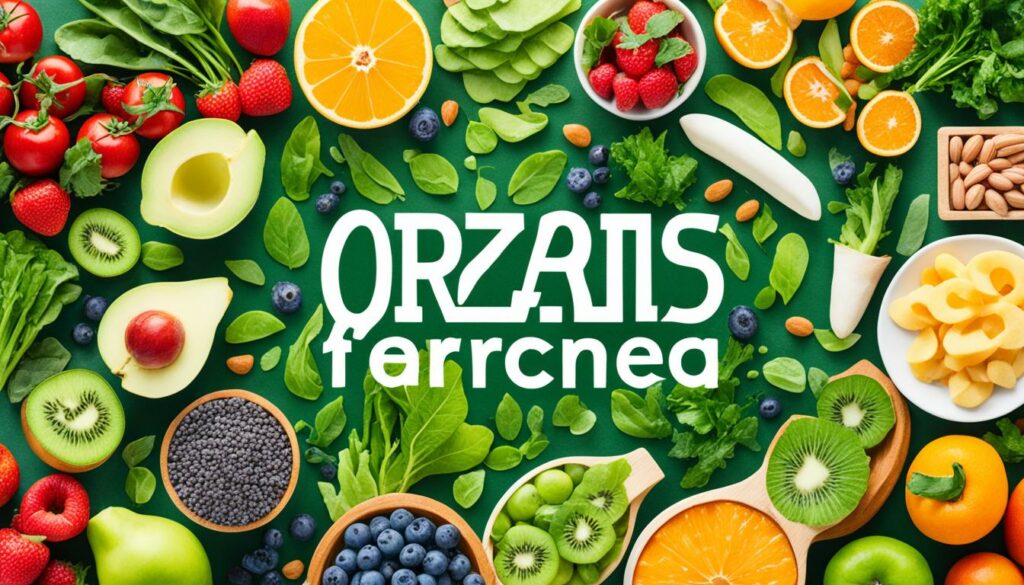
Organic produce led the way, hitting $20.5 billion in sales. This makes up more than 15% of all fruit and veggie sales in the U.S. Avocados, berries, apples, carrots, and salads were the big hits. They show people love fresh, healthy fruits and veggies.
Grocery sales reached $15.4 billion. This area grew by 4.1%, thanks to items like bakery goods, breakfast items, and baby food. It highlights how people want tasty, nutritious organic foods for their daily meals.
Organic drinks hit $9.4 billion in sales, up 3.9% from last year. Health-focused drinks and non-alcoholic choices are becoming more popular. This category keeps growing by offering more choices to fit people’s different tastes and needs.
Sales for organic milk, cheese, yogurt, and eggs grew by 5.5% to $8.2 billion. This rise shows more people are choosing healthier, eco-friendly dairy. For many, ensuring the food they eat is free from added hormones is key.
| Category | 2023 Sales (Billions USD) | Growth Rate | Key Products |
|---|---|---|---|
| Organic Produce | $20.5 | 2.6% | Avocados, Berries, Apples, Carrots, Packaged Salads |
| Organic Groceries | $15.4 | 4.1% | In-store Bakery Items, Dry Breakfast Goods, Baby Food |
| Organic Beverages | $9.4 | 3.9% | Functional Beverages, Non-Alcoholic Options |
| Organic Dairy and Eggs | $8.2 | 5.5% | Milk, Cheese, Yogurt, Eggs |
The organic market in the United States stayed strong in 2023, despite inflation. Sales of organic products hit nearly $70 billion. Consumers stayed committed, valuing health and sustainability.
A 3.4% bump in organic market sales was mainly due to inflation. Prices went up for many organic products. But, the gap in price between organic and non-organic items narrowed. This change made organics more appealing to shoppers.
More than half of organic foods saw their sales go up in dollars. And nearly forty percent sold more in units. Organic produce was very popular, hitting $20.5 billion in sales alone.
Consumer behaviour responded by valuing organic items more, despite these price changes. People kept buying organic goods, encouraged by the smaller price difference with non-organic options.
The organic grocery sector grew to $15.4 billion in sales. People trusted in products like bakery goods and baby food. The organic beverage market also rose to $9.4 billion, thanks to a jump in drinks.
This shows a group of consumers are dedicated to choosing organic. For them, the value of organic stays high, even with inflation. They continue to choose healthier, greener products.
Inflation sparked changes that made consumers stick with organics more. This loyalty suggests continued success for the market, despite economic ups and downs.
In 2023, the USDA Organic label became very popular. This label is a cornerstone of trust for people who buy organic. It shows the product meets strict organic standards, proving they are good for both health and the planet.
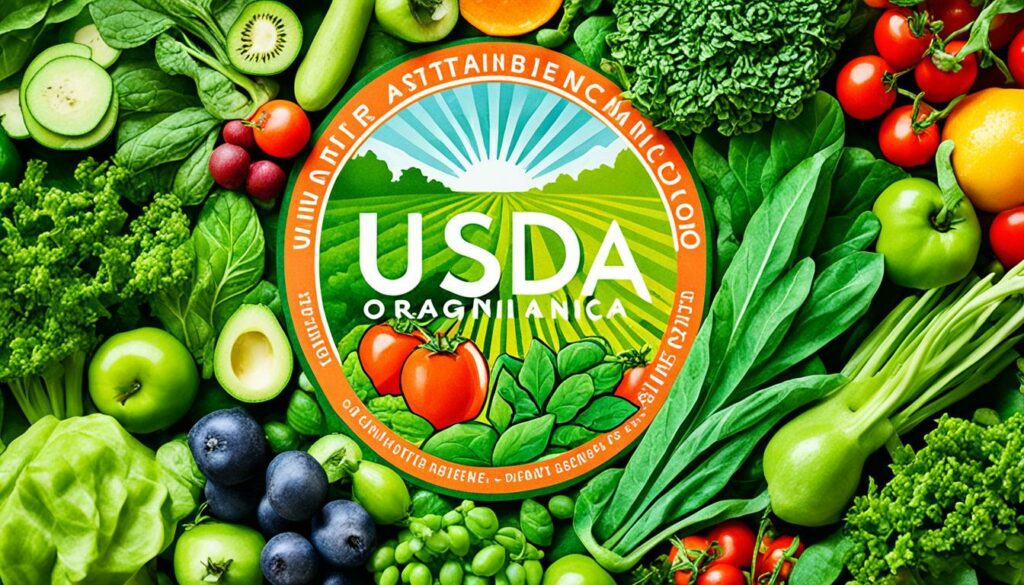
The USDA Organic label is trusted for its honesty and reliability. Thanks to the rules and checks by USDA-accredited certifiers, people know these products are safe. They are sure that no antibiotics, hormones, or synthetic pesticides are used.
This trust comes from the hard work organic farms and businesses do. They are checked every year to keep their organic status. This means the label is very reliable.
The USDA Organic seal does more than build trust. It shows the product follows top organic standards with the newest rules checked often. This makes organic farming better for the earth, meeting people’s need for environmentally responsible options.
Also, the seal helps people understand what they’re buying in a crowded market. It proves that the product is real and good for the planet. This way, people make smart choices when shopping.
Additionally, the USDA makes sure every step of making the product is clear. This includes careful record-keeping and regular checks to stop fraud. With more organic farms and sales, the USDA Organic label plays a big part in showing this growth is real and good.
To sum up, the USDA Organic label is key for trust and high organic standards. It guides consumers and supports the organic sector well.
The organic market has changed a lot, mainly because of Gen Z and Millennials. These young people care a lot about the planet. They want to buy things that are good for the Earth. Plus, they live in ways that are very different from before. This has all made a big impact on what is sold in the organic market.
Most Gen Zers, that’s 76% of them, think about the Earth when they buy food. Half of them worry about the environment and climate change a lot. This shows in what they choose to buy. They also like cooking in new, creative ways, which makes them even more unique.
Companies are learning to meet these young people’s needs. A study found that 72% of Gen Z thinks the current food system is not great. They prefer organic food because they see it as better for them and the world.
Gen Z is also big on social media. They listen to influencers when it comes to food. This opens up new ways for organic brands to catch their eye through social media.
Millennials are also big on going green. They often choose organic and local food. A survey from Deloitte showed that many of them are trying hard to live in ways that help our planet. This includes simple things like turning off lights when not needed.
Gen Z will soon have a lot of spending power. By 2030, they could make up a big part of the market. This means their interest in organic products will keep making a difference.
| Key Metrics | Gen Z | Millennials |
|---|---|---|
| Importance of Sustainability in Purchases | 76% | 63% |
| Concern About Environment and Climate Change | 51% | 48% |
| Sources Information from Social Media Influencers | 70% | 55% |
| Daily Modifications for Sustainability | 63% | 68% |
Young people’s changing needs mean the organic market must always evolve. By meeting Gen Z and Millennials with green products and honest messages, it can continue to grow and change for the better.
The US market for organic goods shows big differences between regions. These come from local money matters, what folks like, and how easy it is to find organic stuff. Knowing these differences well is key. It helps brands focus their efforts on the right people.
The Corn Belt had more people buying organic, with sales up to 8% in 2021 from 6% in 2012. This shows folks are more into organic food there. On the flip side, the Delta had a huge jump in sales, going from just $4 million in 2012 to an incredible $143 million in 2021. That’s a 3,582% increase!
Normal grocery stores became the top spot for buying organic food in 2021, getting 55.6% of the sales. This beat natural food stores. Buying straight from the producer also got more popular, making up 12.6% of all the sales. This change shows people are loving the convenience of getting organic food from regular stores.
People in different regions like different organic foods, too. In 2023, the South bought the most organic food, with a 3.4% increase. The West and Northeast, though, saw fewer sales. Berries were the best seller for the second year, making $1.66 billion in sales. Packaged salads and apples were next. Bananas sold the most by weight, with 538 million pounds, then came berries and carrots.
| Region | Top Organic Produce by Sales ($) | Top Organic Produce by Volume (lbs) |
|---|---|---|
| South | $1.66 billion (Berries) | 538 million (Bananas) |
| West | $1.66 billion (Berries) | 538 million (Bananas) |
| Northeast | $1.66 billion (Berries) | 538 million (Bananas) |
Understanding the details in regional organic sales is vital for everyone in the organic industry. Customising plans according to what people in a region love and can afford is crucial. It boosts how well we meet what consumers want.
In 2023, the world of organic drinks has leaped forward. More people are turning to functional organic drinks and non-alcoholic choices. This change shows a growing interest in health and lifestyle-focused items.
Organic functional drinks are more popular than ever. They attract those who care about their health. These beverages do more than just quench your thirst, they help with focus, hydration, and provide extra nutrients.
In 2020, the global market for organic foods and drinks was worth USD 115,650 million. By 2027, it’s expected to double to USD 232,080 million. Companies like Amy’s Kitchen and Albert’s Organics are leading the way, offering products for all age groups.

Organic non-alcoholic drinks are also making waves. Options like organic mocktails and booze-free wines appeal to people looking for healthier, ethical drinks. This change was sped up by the COVID-19 pandemic.
The U.S. saw sales in the organic drink sector hit $9.4 billion. Drinks like ready-to-drink coffee and tea, as well as nutritional beverages, performed well. The growing demand for such products showcases the industry’s ability to keep thriving.
The organic market keeps growing and changing. It’s obvious in new trends that affect what people buy and how the industry changes. This includes more transparency, new food choices, and a move towards options that are better for us and the planet.
Organic produce is taking the lead as a popular choice. Sales jumped by 5.5% in 2021, showing its strength. People like it because it’s clear what you’re getting. It’s grown without synthetic pesticides and supports farming that looks after the environment. The sales of top items like avocados, berries, and apples went up a lot.
Organic dairy alternatives are also getting more popular. As people change what they eat, they’re choosing drinks like almond, oat, and soy milk more often. Sales of organic dairy and eggs went up by almost 11% between 2019 and 2021. This rise shows how the industry is keeping up with new trends and meeting different needs.
The market for organic personal care is booming. Sales spiked in 2023 as more people choose products that are good for health and the planet.

In 2022, the organic personal care products market hit USD 21.5 billion. It’s expected to grow by 8.4% each year from 2023 to 2032. The rising interest in natural and organic ingredients is a major reason for this.
Skincare is a big part of this growth, earning around USD 7 billion. Men’s interest in these products is also rising, with sales reaching about USD 189 million. This shift shows that everyone is embracing organic personal care.
The organic supplement growth trend is growing too. Sales have crossed the $2 billion mark. People are drawn to these products for their health and wellness benefits.
Parents aged 18 to 34 are a key market. Their interest is helping drive up sales. This trend suggests the organic supplement market has great potential ahead.
| Category | Value in 2022 (USD) | Market Share (%) | t
|---|---|---|
| Organic Personal Care Products | 21.5 Billion | 100% | t
| Skin Care Products | 7 Billion | 32.6% | t
| Men Segment | 189 Million | 0.88% | t
| Low Price Range (5 to 15 USD) | N/A | 51% | t
| Offline Distribution Channel | N/A | 55% | t
| North America | N/A | 35% | t
The organic market is growing fast, but it has its challenges. Two main issues are the supply chain and confusing labels. These could affect its long-term success.
The way organic products are supplied has many challenges. Organic farming needs a lot of resources. This makes it hard for these products to always be available at stable prices.
Organic farming is getting more common worldwide. Still, getting these products out there isn’t easy. This leads to higher costs and sometimes not enough products for everyone to buy. As the market grows in new areas, such as emerging regions, the supply chain needs to keep up.
Greenwashing, or false labelling, is a growing problem in the organic food industry. There are so many labels out there, like “regenerative”. Sometimes, it’s hard for people to know what really means organic. This label confusion makes it tough to trust organic certifications.
The high price of organic food adds to this problem. People expect to pay more for something that is good for them and the planet. But, they need clear and honest labels.
It’s important for everyone involved in making and regulating organic food to work together. They must ensure that organic labels mean something true. This keeps people believing in organic products.
Education is key in making people understand and trust the organic market. This became more important in the mid-2000s. At this time, sellers changed how they grew, moving from emails to social media. Our study shows that teaching consumers about organic products fights scepticism and helps them make smart choices.
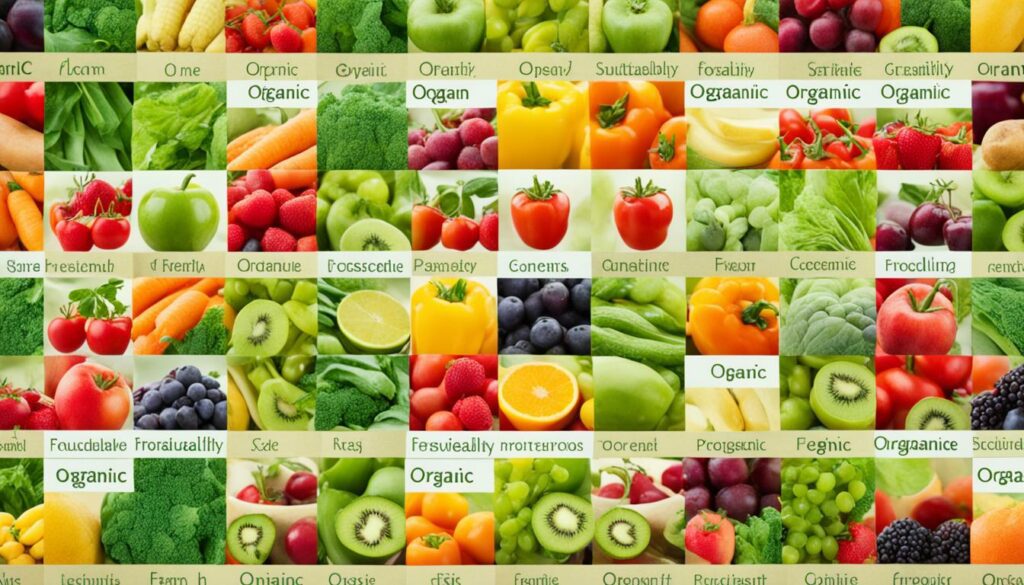
Consumer education is vital for the success of the organic market. A major step was taken in 2012 with the launch of the National Organic Program’s Organic Literacy Initiative. It aimed to enlighten both customers and farmers. The USDA started the blog, Organic 101, and a special email service to make organic stuff clearer. Brands like Stonyfield and Pete & Gerry’s organised events such as the Life is Good Festival to meet consumers. They focused on being open and where they get their products from.
The Organic Trade Association (OTA) leads big campaigns to talk about the benefits and standards of organic food. A survey in 2011 showed a 9.4% increase in sales, reaching $29.2 billion. These efforts help fill the gap in people’s understanding and encourage them to make choices that are good for their health and the planet. The OTA highlights the need for farms to be organic for three years before they get the USDA label.
By doing this, the campaigns make consumers trust the organic seal more. With the move into the digital era, teaching online not only boosts what customers know but also builds a stronger bond between them and organic brands.
| Year | Initiative | Impact |
|---|---|---|
| 2012 | Organic Literacy Initiative | Increased organic literacy among consumers and farmers |
| 2011 | OTA Organic Industry Survey | Reported 9.4% growth in organic food sales |
| 2017 | Social Media Utilisation | Improved engagement and consumer trust |
The US organic market is set to grow steadily. This growth is because more consumers are choosing organic. Predictions show a bright future for this sector, thanks to improving consumer knowledge and views.
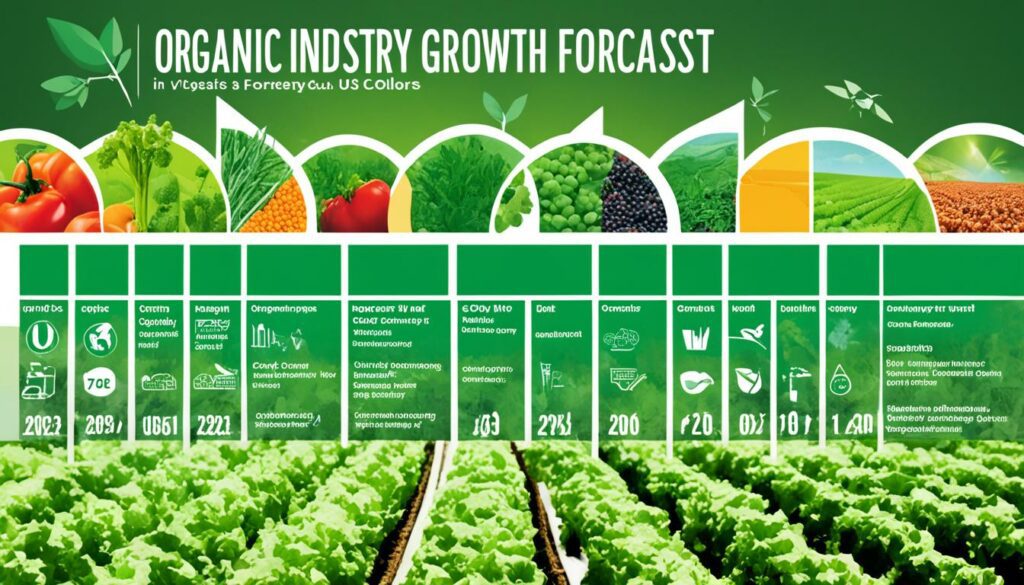
The amount of land used for certified organic farming has grown by 79 percent since 2011. It now covers 3.6 million acres. In the same period, organic retail sales in the US nearly doubled to $52.0 billion. This shows that people are choosing organic more than before.
Studies suggest people are more focused on health and the environment when buying products. In 2016, over 80 percent of US families bought organic food. Younger generations, such as Millennials, are a big part of this movement because they care a lot about the planet. Even online sales of organic food are increasing, reaching 6 percent in 2020.
| Year | Total Organic Sales ($ Billion) | Organic Fresh Fruits & Vegetables Sales ($ Billion) | Proportion of Organic Produce |
|---|---|---|---|
| 2010 | 26.9 | 10.8 | 40% |
| 2021 | 52.0 | 19.2 | 40% |
The future looks bright for the US organic market. As more people learn about it and prices become more affordable, we expect a continued interest. This will help the organic market keep growing in the years to come.
In 2023, the US organic market is set for big growth. Our study shows the organic food market worldwide was worth USD 163.1 billion in 2022. It’s expected to hit USD 219.3 billion by 2030, with a yearly increase of 6.1%. People are choosing more healthy and eco-friendly options, which is driving this growth.
Many people think organic foods are better for health and safety. But, they are often more expensive than regular foods. Still, with more people wanting to choose eco-friendly and sustainable foods, the organic market is seeing big opportunities for growth. It’s expected to grow even more, reaching USD 327,802.0 million by 2027, with an impressive yearly growth.
The future of organics is bright, thanks to new ideas and understanding who buys it. Big names like The Kroger Co., Dean Foods, Organic Valley, and Whole Foods Market play a big role. Even in tough times, this sector is ready to meet the needs of eco-conscious consumers. This overview shows the exciting path ahead for the organic market.
The organic sector in the US grew a lot in 2023, hitting about billion. This was because prices went up and people wanted healthier and greener options. More organic fruits and veggies, groceries, drinks, and dairy substitutes sold well.
Inflation tried to slow down the organic market, but it didn’t work. Even though prices rose, people still bought organic goods. This shows they really value these products. Also, the price gap between organic and non-organic items got smaller, which people seemed to like.
In 2023, organic fruits and veggies led the way with sales topping .5 billion. Next came organic groceries at .4 billion, followed by organic drinks with .4 billion. Organic dairy and eggs brought in .2 billion.
The USDA Organic label is very important to shoppers. It means the product meets strict rules for being organic. Consumers trust it for the product’s health and green benefits. It helps them choose what they buy.
Youth is changing the organic market by caring more about what they eat. Millennials and Gen Z look for brands that match their eco and ethical values. They’ll shape the future by preferring organic and sustainable options.
Organic sales change a lot across the US. Different areas buy more organic stuff for various reasons. Understanding these differences in taste and need is key to selling organic goods to everyone.
Many cool new organic drinks hit the market in 2023, especially healthy and non-alcoholic ones. Special drinks made to hydrate or sharpen your mind grew popular. People also began to like non-alcoholic organic drinks more.
Selling organic can be tough right now because of supply problems and price hikes. Also, new terms like “regenerative” farming are confusing customers about what’s truly organic.
Teaching people about organic benefits really boosts sales. Being informed helps buyers choose wisely. The Organic Trade Association’s educational work is vital in showing the true worth of the organic seal and clearing up any confusion.
The US organic market will keep growing, thanks to people knowing more about organic goods. Plus, the cost difference between organic and non-organic items is getting smaller. People’s focus on health and the environment will drive this growth forward.